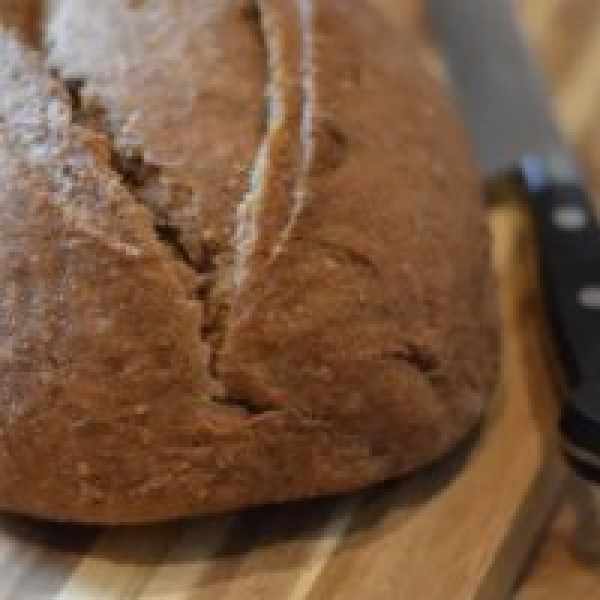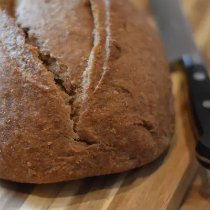


Ingredients:
2 1/2 C warm water (100-110 degrees)
1 packet or 1 T yeast (regular or quick rise)
2 T oil or melted butter (optional)
1 T brown sugar, honey, or other sweeteners
6 C flour (A good combination is: 2 1/2 whole wheat and 3 1/2 white. You may use a combination of whole wheat, white whole wheat, all-purpose white flour or bread flour. You may substitute I C wheat germ or flax seed meal for 1 C whole wheat flour. If adding wheat germ or flax meal, add it with the yeast so that these heavier flours can soften as yeast activates.)
1 T salt
Directions:
- Sprinkle yeast onto the water. Stir or whisk to wet yeast granules completely. Mix sweetener and oil, if using, into the wet ingredients until dissolved. Let stand for about 10 minutes as the yeast activates. As you wait, gather and/or measure other ingredients. Grease your pans.
- Stir the dry ingredients into the wet ingredients gradually to make a soft, somewhat sticky dough, adding the salt toward the end.
- Turn dough onto a lightly floured surface for kneading. Kneading dough is as simple as pushing the dough away from you with the heel of your palm, folding it over itself with your fingers, and pulling it back. Adjust the amount of flour so that the dough does not feel waterlogged or runny. If it feels too stiff and you feel strain in your fingers as you knead, add a sprinkle of water. Knead for about 10-20 minutes until the dough loses its wet quality and you can see specks of bran against a lighter dough. It might still be a bit sticky.
- Clean the bowl and oil it lightly. Shape the dough into a smooth ball and put it in the bowl. Move it around in the bowl to collect some oil and then turn it over. Cover the bowl with plastic wrap or a dry towel. Be sure there is enough room for the dough to double. Keep the bowl in a warm, draft-free place until doubled, about 30-45 minutes, up to an hour, as time allows. This develops flavor as well as lift.
- When the dough is doubled, let it rise a second time, if time allows. This means to deflate the dough, form it into a ball, return to the bowl and cover for another 45 minutes. You can skip the 2nd rise. However, this develops flavor.
- Divide dough into 2 large or 3 small loaves. Squeeze out any air and shape or roll tightly into loaves, making sure the seam is tight and on the bottom as you place them each in a greased pan. Cover and let rise again, until dough rises to just above the top of the pan, about 30 minutes. Slit the loaf in several places with a sharp knife or razor to let air escape in the oven. This can be done once diagonally across the length of the loaf or several times diagonally across its width. Bake at 375 degrees for about 25 – 35 minutes or until the internal temperature of the loaf is about 185-190 degrees.
Story:
Christians celebrate 50 days of Easter, giving us time to celebrate Resurrection transformation: to be of service, forgive, prayerfully plant seeds, surrender to joy, bake bread. A Basic Bread Recipe guides us to bake this "transformational Easter food!" Also included: a reflection inspired by baker theologian Peter Reinhart called From Wheat to Eat.
Transformation From Wheat to Eat
On Holy Thursday, Christians celebrate Jesus by giving thanks, breaking bread, and sharing with his friends. Christians believe that ordinary food is transformed into Christ’s very presence and promise to be among us always. Fed by the Eternal Word made Flesh, we can discover goodness in each person, each living thing. The FSPA to whom we are drawn has a particular focus on the Eucharist, the bread of life.
A wheat seed planted in the dark earth is warmed, fed, and watered. It breaks open and dies.
Without its protective shell, it lives again, transformed into a rising green blade of wheat.
When mature, wheat stalks are harvested, cut down, and killed.
Separated from straw and chaff, some seeds are planted, the next generation, a sign of God’s promise.
Other seeds crushed between stones are never to give birth, dying once more and transformed into flour.
Human hands mix flour with water to form a sort of "clay", which in Hebrew is the same word as “Adam” or "human!"
Yeast - a living mix of organisms found in the air - is added. Reactivated in water, yeast transforms a lump of dough from clay to bread.
Fed by honey or molasses and the sugars in the flour, sister yeast eats sugar and emits carbon dioxide. Eating sugar and burping air, it leavens and gives lightness and flavor to dough that otherwise would be dense and heavy.
As hands knead this potential food, protein (gluten) in the wheat flour is stretched, and cross-knitted into elastic, pliable strands. The capacity to rise and become something new is nurtured through rhythmic work.
The dough must now rest, expanding slowly, in a warm place. The baker deflates the dough and undisturbed, it rises again.
Skilled hands form risen dough into loaves and place them in pans for one last rise. The beautiful loaves now must be slashed to let air escape in the heat of the oven. In Italian, the oven is “il forno” and in a wonderful unity of roles, the baker (also called "il forno") receives bread for baking.
Heat brings more change. Does it ever end? At a certain temperature, sugars in the pale dough caramelize and form a brown crust. Heated even more, the yeast dies, having given itself completely. When the bread comes from the oven, its transformation continues. The crumb and texture continue to take shape. Bread cools. We eat. This transformational food becomes us, uniting all who bless, break and share him. We become what we receive, one loaf, one Body, transformed into food for others.
If you would like to be notified when we share new recipes, be sure to scroll to the bottom, provide your email address, check the box confirming you are not a robot, click on a few photos to prove it and click subscribe! You will then receive an email after each new post. Remember, we're always looking for new recipes, so keep sending them to ecopact@fspa.org!





Post a Comment